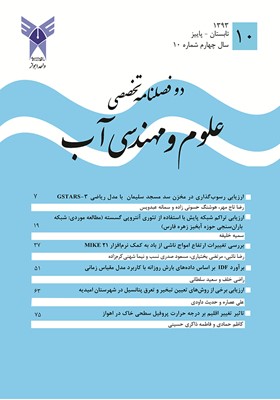Estimating IDF based on daily precipitation using temporal scale model
الموضوعات :
1 - گروه آبخیزداری، دانشگاه صنعتی، اصفهان، ایران.
2 - گروه آبخیزداری، دانشگاه صنعتی، اصفهان، ایران.
الکلمات المفتاحية: منحنی IDF, رگبار طرح, نمایه مقیاس و مدل مقیاس,
ملخص المقالة :
The intensity –duration –frequency (IDF) curves play most important role in watershed management, flood control and hydraulic design of structures. Conventional method for calculating the IDF curves needs hourly rainfall data in different durations which is not extensively available in many regions. Instead 24-hour precipitation statistics were measured in most rain-gauge stations. In this study, scaling properties of extreme rainfall are examined to derive scaling IDF curves over different durations. This new method in comparison with traditional method is less computational steps and has lower parameters numbers which causes increasing in reliability of IDF curves. Scaling method was used to extract the IDF curves in Ahwaz rain-gauge station and results proved the efficiency and robustness of the scaling method. The accuracy of scale model method for Determining precipitation intensity, with Duration 30 to 180 minuts in Ahwaz station, is quite acceptable and maximum error is about 11.5%.
قهرمان، ب. و آبخضر، ح. ر.(1383). اصلاح روابط شدت-مدت-فراوانی بارندگی در ایران. علوم و فنون کشاورزی و منابعطبیعی، سال هشتم، شماره دوم.
نوری قیدار م. ح. (1388). استخراج منحنیIDF برای دوام های کوتاه مدت از داده های روزانه با استفاده از مشخصات مقیاس زمانی بارش. مجموعه مقالات پنجمین همایش ملی علوم و مهندسی آبخیزداری (مدیریت پایدار بلایای طبیعی) .دانشگاه علوم کشاورزی و منابع طبیعی گرگان.
Baghirathan , V. R. and Shaw, E. M. (1978). Rainfall depth – duration - frequency studies fo SriLananka, Journal of Hydrology, 37(3), pp: 223-239.
Bell, F.C. (1969). Generalized rainfall duration frequency relationships. Journal of Hydraulic Div.,ASCE, 95(1), pp:311-327
Burlando P. and R. Rosso. (1996). Scaling and multiscaling models of depth – duration – frequency curves for storm precipitation . Journal of Hydrology, 187, pp: 45-65
Chen,C.L.(1983). rainfall intensity-duration-frequency formulas ,J.Hydraul.Eng.,ASCE 109(12), pp:1606-1621.
Chow, V.T. (1964). Handbook of Applied Hydrology, McGraw-Hill, New York, pp: 1-1450
Diaconis,P. and B. Efron. (1983). Computer intensive methods in statistics, Scientific America, 5, 248, pp:116-130.
Ferreri, G. B. and Ferro, V. (1990). Short duration rainfalls in Sicily, Journal of Hydraulics Engineering , ASCE, 116(3), pp: 430-435.
Hershfield, D. M.(1961). Rainfall frequency atlas of the United States,Technical paper.40,U.S. Weather Bureau Washington,D.C.
Kothyari, U. C. and Grade, R. J. (1992) Rainfall intensity – duration – frequency formuls for India, J.Hydr.Engrg., ASCE, 118(2), pp: 323-336
Koutsoyiannis, D., Manetas, A. (1998). A mathematical framework for studying rainfall intensity – duration –frequency relationships, Journal of Hydrology, 206, pp: 118-135
Menabde M., A. Seed and G. Pegram. (1999). A simple scaling model for extreme rainfall. Water Resources Research, Vol. 35, No.1, pp:335-339
Neimczynowicz, J. (1982) Areal intensity – duration - frequency curves for short term rainfal events, Nordic Hydrology, Vol.13(4), pp: 193-204.
Nhat, L. M.,Tachikawa, Y. and Takaka, K. (2006a). Establishment of IDF relationships for monsoon areas, Annual of Disas. Prev. Rrev. Inst., Kyoto University, No. 49B, pp: 93-103.
Poo Sshan Yu, T. C. Yang and C.S. Lin. (2004). “ Regional rainfall intensity formulas based on scaling property of rainfall”, Journal of Hydrology, 295(1-7), pp:108-123.
Raudkivi, A. J. (1979). An advance introduction to Hydrological Processes and Modelling , Oxford Pergamon Press, N. York, N.Y.


